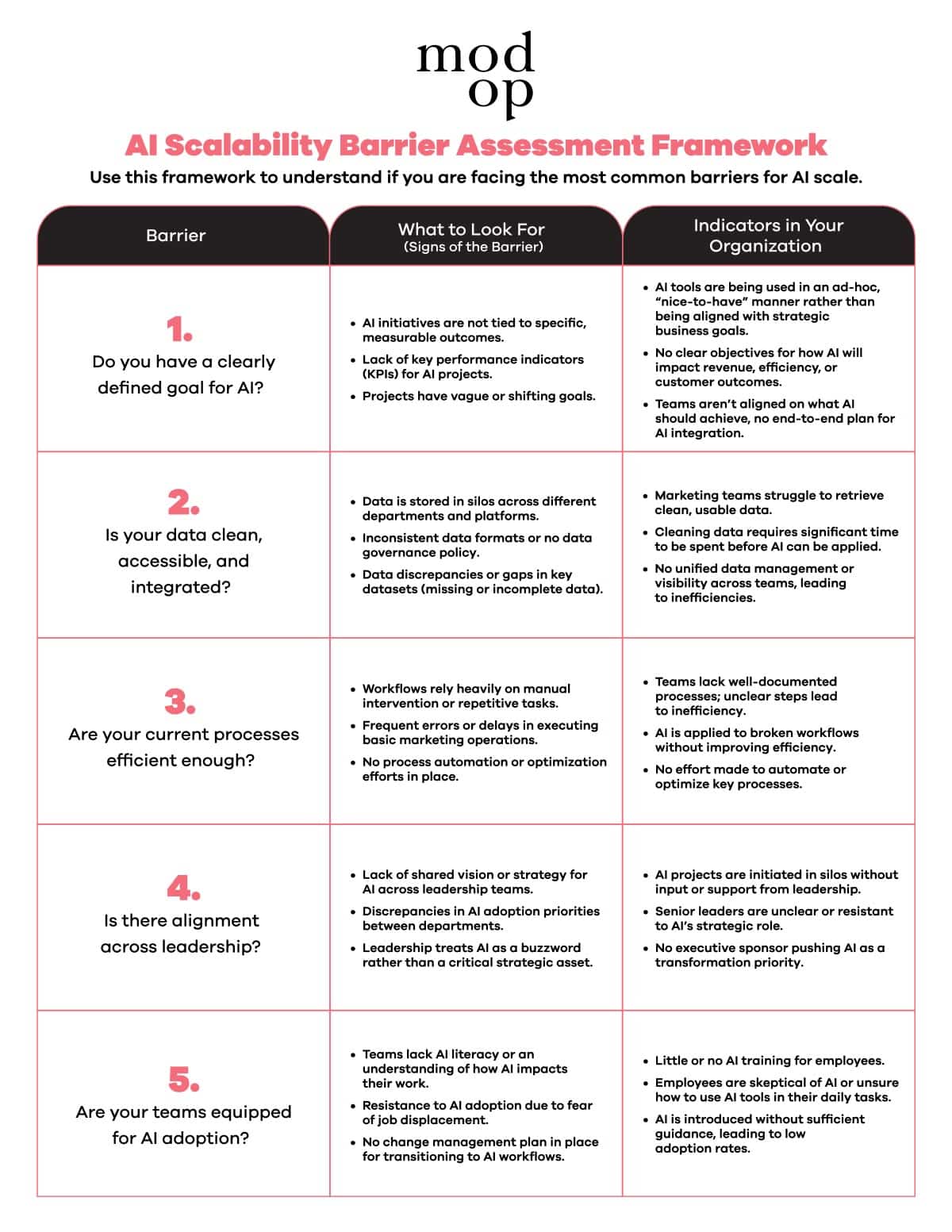Coming out of MAICON 2024, one thing is very clear: organizations still cannot scale AI. Multiple sessions covered the top barriers, biggest gaps, and hardest challenges we struggle to solve. This brings us to the second key point – scaling AI is a serious business strategy. (Big shout out to Gary Survis, Ashley Gross, and Jessica Hreha for their MAICON material that inspired this post).
To scale AI effectively, you need to stop treating it like a series of disconnected experiments and instead take a serious, strategic approach. Here’s how to assess and overcome the common barriers to AI scalability like a well-run, mature organization:
Assess Your AI Pilots and Workflow Experiments
Take stock of your current AI pilots and where you’re experimenting with AI. Are these initiatives tied to clear business goals, or are they more “random acts of AI”? Review what’s working and what’s not by examining the outcomes and how they’ve integrated into broader workflows.
Professional Take: Assess each initiative’s ROI and alignment with long-term business objectives. Determine if these AI tools are solving a significant problem or merely offering a short-term, surface-level fix.
Identify the Barriers to Scaling AI
Compare your existing AI initiatives against the common barriers to scale:
- Do you have a clearly defined goal for AI, or is it just “nice to have”?
- Is your data clean, accessible, and integrated across systems?
- Are your current processes efficient enough for AI to be applied effectively?
- Is there alignment across leadership and the organization on the AI strategy?
- Are your teams ready and equipped to adopt AI in their workflows?
Address Each Barrier Like a Mature, Scalable Business
You can’t half-heartedly apply AI solutions if you want to scale. Here’s how to systematically solve these barriers with a serious, grown-up business mindset:
- Set Clear, Measurable Goals: Define exactly what you want AI to achieve for your business. This is foundational. No goals, no scalability.
- Fix Your Data: Conduct a full data audit. Clean, organize, and integrate your data across systems. No more siloed, fragmented data if you expect AI to be effective. If this sounds impossible, our Mod Op Strategic Consulting group will help you.
- Optimize Processes First: Don’t apply AI to broken processes. Streamline and document your workflows, then look for where AI can genuinely augment or automate tasks.
- Align Leadership and Teams: Ensure leadership buy-in and clear communication around AI initiatives. This isn’t just about tools; it’s about transforming how your organization works. Bring teams along early, get their input, and ensure they have the skills they need to adopt AI at scale.
Last: Commit to Iterative Improvements – This Is a Journey
Scaling AI isn’t a one-and-done process. Even after overcoming these barriers, it’s essential to constantly review, refine, and optimize. Approach AI adoption with the same rigor you would apply to any other major business transformation.
In short, treat AI like what it is — a high-priority business initiative: with a clear strategy, the right tools, and the commitment to doing the hard work required for true scalability.
The Latest
We study the game as hard as we play it.
Learn with us what’s now and next.
Related Stories
What does it truly mean to “become digital”? What if I told you that it isn’t about technology? That to plan a digital transformation, technology is the last thing you should think about?
I recently co-authored a book with Mod Op’s Eric J Bertrand and Jonathan Murray that addresses the challenges of digital transformation. The book, “Getting Digital Done,” reveals how companies can effectively make digital, data, and AI transformations to stay competitive in a rapidly changing market.
This post (and others to come) distills some of the learnings from the book – but please check it out, as it offers far more detail and comes with a range of tool kits, checklist, and lessons learned.
Above all, becoming digital is a significant transformation that can be the chief driver of success in the modern business landscape.
Tackling Business Problems
Mod Op Strategic Consulting helps clients with the strategy and execution of digital transformation, but they typically do not come to us and demand, “Make us digital!” Instead, they talk about a business problem: their customers want something that they’re not equipped to provide; they don’t have the data, or it’s not joined up; their infrastructure is running out of capacity; their competition has leapfrogged them; they see opportunities to innovate but they just don’t have the tools, systems, or people, or processes needed to execute effectively.
It’s Not (Just) About the Technology
When we talk about becoming digital, people instantly think it’s all about technology. The truth, however, is that technology is usually at the end of a long list of things to be considered. It’s easy to conclude that you just need to find the right software or AI solution, and everything will fall into place. I’ve seen firsthand how this mindset can lead to costly mistakes. Many companies spend millions on new technology only to find that their teams can’t or won’t use it.
To truly transform, you need to start with your people. You need to build a culture that embraces change and is open to new ways of working. You must also make sure that your processes are aligned with your business goals and that your digital capabilities evolve to support those goals.
Digital is not a piece of equipment or software. It’s a mindset. To succeed today, an organization must be a data-driven, digital business. Customers and partners (not to mention employees) expect business to be conducted online, in a frictionless environment, and in a personalized way.
Digital is a Mindset
What does this mean in practice? It requires a fundamental shift in how the entire organization runs. This includes:
- Building a data-driven culture. In a digital world, data is a foundational business asset. Successful companies use data to inform everything they do, from product development to marketing.
- Breaking down silos and integrating business functions. Information needs to flow seamlessly throughout the company. Departments need to work collaboratively, not in isolation.
- Prioritizing customer needs. Companies must adopt a customer-centric approach, putting the needs and experiences of their clients at the center of everything they do.
Technology is definitely part of digital transformation, but it’s the last step, not the first. The goal is to build a bridge from the past to the future. We work with our clients to develop a clear roadmap for digital implementation, providing guidance and support every step of the way. The challenge is navigating change, not installing software.
Looking for more? Check out our book: “Getting Digital Done: An Executive Guide to Growth and Transformation”.
The Latest
We study the game as hard as we play it.
Learn with us what’s now and next.
Related Stories
Social media platforms have been around for nearly 30 years in one form or another. Yet there are brands who continue to question whether a social media presence is worth the time and effort needed to support it.
In 2024, it is estimated that 5.17 billion people worldwide use social media platforms, with the average individual using 6 different social platforms per month (Credit: Sprout Social).
The question is not whether a brand should invest in its own social media presence (because the answer is a resounding YES!), but where they should invest, and how. No two social media platforms are the same, even if they are owned by the same company – looking at you, Meta. Audience demographics, user intention, creative nuances and best practices differ among platforms, which makes it vital for brands to consider many business factors before committing to social media.
Audience Demographics and User Intent
Let’s start with the differences in audience demographics and the way users interact with each other and brands across platforms.
According to Sprout Social, the below shows the platforms most used by each age range:
- 18-29 year olds – TikTok, Instagram, Snapchat
- 30-39 year olds – LinkedIn, X (formerly known as Twitter), Instagram, Snapchat
- 40-49 year olds – LinkedIn, Facebook, X (formerly known as Twitter)
- 50-59 year olds – Facebook, LinkedIn, Pinterest
The above does not mean users in these age ranges are not on other platforms. It shows the platforms where these specific users spend most of their time. That’s why brands targeting millennials might look at social strategies that include platforms like Instagram, Facebook, Twitter and TikTok. But age isn’t the only factor to consider. User intent and brand objective/goals are also key factors.
A B2B brand’s core audience typically includes decision-makers from other businesses. The best place to find those individuals? LinkedIn. That doesn’t mean other platforms aren’t suitable for a B2B brand, but when looking at user intent on each platform, LinkedIn is the best place to reach decision-makers who may already be in a business-oriented mindset. Those decision-makers may also have a presence on Facebook and/or Instagram, but how they use those platforms likely differs from how they use LinkedIn.
For B2C brands, there may not be a single best platform, but rather multiple ones. Companies interested in ecommerce targeting millennials and younger generations may find significant success on platforms like TikTok, Instagram and Facebook where product-focused content performs well and users are more inclined to be in a shopping mindset. Depending on the brand’s core audience and how they intend to use their channels, a multi-platform strategy may be in the brand’s best interest.
One notable change on social platforms in recent years is the way users interact. It’s important to consider what a user may be hoping to find on a given platform, as well as how the brand can best capture that user’s engagement. A good example, given the explosion of shoppable content on TikTok, is how individuals use the platform to review products. More users are turning to social media platforms to search for product reviews, particularly video reviews, instead of using Google. They’re searching for reviews from their favorite creators and influencers, but also from “real” people who haven’t been sponsored to speak about a specific product.
Creative Nuances Between Platforms
There are other factors to consider when reviewing the level of investment needed for a strong social strategy. First, social media marketers should understand both the brand’s creative limitations and each platform’s specific content requirements. While there are similarities among platforms, and content can be cross pollinated to surround a brand’s audience, each platform has specific nuances to keep in mind.
Several platforms are moving away from static images as the preferred content and now have algorithms that prioritize video content, but not just any video content. Instagram and TikTok are optimized for 9:16 video aspect ratios, while other platforms may be optimized for 16:9 or 4:5. However, between TikTok and Instagram, length of video, safe zones, thumbnail needs and specific placement (IG Reels or IG Stories) differ. All affect the design needs of the asset.
If a brand does not have resources or content for videos, a social content strategy may need to focus less on video-centric platforms. For example, successful TikTok content relies heavily on trending themes, creator collaborations, human-centric content and, within the past year, shoppable products. A brand with little content that meets those criteria should limit its investment in TikTok even if it is a core platform for its audience.
Yet even when we create an effective social media strategy with all of this in mind, social likes to keep us on our toes. The platforms are in a constant state of change as they compete against each other.
Staying Up To Date With the Ever-Changing Nature of Social Media
As new platforms emerge or new trends and features pop up, existing platforms implement new or similar features. This means that defined social strategies need room for growth and adjustments to align with changing platform features and best practices.
See below for some, but not all, of the changes already implemented or being rolled out on social media platforms in 2024:
- Instagram:
- Instagram grid changing from 1:1 to a 4:5 view (rolling out in Beta currently)
- Instagram Stories font interface changes
- Instagram increases carousel limit from 10 to 20 slides
- TikTok
- TikTok contract with UMG expired, resulting in countless music tracks removed from the platform and posted content, then signed a new contract with UMG
- TikTok partnering with Amazon for ease of in-app purchasing
- TikTok launches commercial music library
- TikTok enables 60-minute-long video options
- TikTok integrates an option to add post collaborations
- X/Twitter
- X/Twitter Premium and Premium Plus subscriptions changes
- X/Twitter user post likes are now private
- LinkedIn
- LinkedIn introduces sponsored newsletters
- LinkedIn introduces messages for pages
- LinkedIn introduces a new short-form video interface
- Meta/Facebook
- Meta ads-free subscription in Europe
- AI integrations, including an AI chatbot and AI summaries of post comments
With the sheer number of changes listed above, and even more on the horizon, brands need both a defined, yet evolving social strategy, and a team of social professionals with their thumb on the pulse of this ever-changing world of social.
The Latest
We study the game as hard as we play it.
Learn with us what’s now and next.
Artificial Intelligence (AI) is everywhere, but its potential impact on SEO practice is one of the most exciting changes we foresee. In fact, as we look ahead to 2025, the synergy between AI and marketing strategy will transform the way businesses engage with the search experience. The changes aren’t just about refining what we already do; they amount to a significant and exciting overhaul of how we interact, optimize, and engage.
As it reshapes our business, AI will bring plenty of challenges as well as opportunities. Fortunately, Mod Op is uniquely prepared to steer through these changes.
What are the transformative impacts of generative AI on Search Experience?
Automation of SEO Tasks:
AI’s capacity to automate intricate and repetitive tasks is revolutionizing SEO. Today’s algorithms can sift through vast datasets with a speed and accuracy that no human can match, facilitating real-time SEO adjustments. The impact of AI even extends to optimizing content for long-tail keywords, refining meta descriptions, and enhancing website structures—all in alignment with the ever-evolving search engine algorithms
Content Creation and Personalization:
Generative AI has the power to produce high-quality, pertinent content at an unprecedented scale. Through advanced natural language processing (NLP) models, the technology can craft articles, blogs, and web copy that are not only search-engine optimized, but also finely tailored to the preferences and behaviors of the audience. This dual focus is enormously advantageous because it ensures that the content is both search-engine friendly and deeply engaging – a win-win
Predictive Analytics and Consumer Insights:
We’ve seen that AI can be used to forecast trends and user behavior by analyzing historical and contemporary data. These insights empower businesses to preempt market shifts, grasp consumer preferences, and develop strategies that are aligned with changing demands. For search marketing, this prescience translates to adapting keyword strategies and content plans proactively, securing a competitive advantage for businesses
What are some of the challenges presented by AI in Search Marketing
Ethical Considerations and Bias:
Of course, the use of generative AI raises significant ethical questions, including the risk of inherent biases within AI algorithms. Algorithm bias could potentially distort content generation and search strategies, leading to an inaccurate emphasis or misrepresentation of demographic groups. To mitigate these risks, we need to be constantly vigilant and ready to refine AI training data to maintain fairness and precision.
Is overreliance on Automation a bad thing? Yes.
While AI significantly boosts efficiency and effectiveness, excessive reliance on it can dampen the creativity and innovation of new search strategies. Marketers must find an optimal balance, leveraging AI for routine tasks while preserving human ingenuity for strategic decision-making.
Keeping Pace with AI Advancements
AI technology evolves at a breakneck pace, making today’s cutting-edge tools potentially obsolete tomorrow. To stay agile, businesses must continually educate themselves about new tools and techniques to stay relevant in a rapidly changing landscape.
Mod Op’s Strategic Preparation for AI-Driven Search Marketing
At Mod Op, we understand the potential and challenges of AI in search marketing, and our AI Council has proactively woven the technology into our strategic framework
Investing in AI Tools:
Mod Op has committed to advanced AI technologies that not only enhance operational efficiencies, but also improve client outcomes. These tools are consistently updated to keep pace with the latest AI developments, ensuring our leadership in AI application within the marketing sector
Ethical AI Usage:
At Mod Op we maintain stringent ethical standards in our use of AI, ensuring all applications are free of biases and respect user privacy. We conduct regular audits and updates to keep our standards high
Balancing Automation with Human Creativity:
While Mod Op uses AI for data analysis and routine tasks, strategic decisions need a blend of AI-driven insights and human creativity. Only a balanced approach gives rise to effective solutions that precisely meet client needs. Innovation demands the human touch
Continuous Learning and Adaptation:
With AI continually evolving, Mod Op places a high priority on continuous learning and professional development for our team. This commitment ensures that staff members are proficient in using the latest AI tools and approaches
As we move toward 2025, the central role of AI in reshaping search marketing is unmistakable. The field is rife with challenges, yet it also teems with opportunities for exciting innovation and growth. Mod Op, fortified by strategic investment and a commitment to ethical AI practices, is navigating this evolving terrain. Our proactive stance on AI places Mod Op at the forefront of digital marketing evolution, setting a benchmark for the industry by leveraging AI to mold the future of search experience marketing.
The Latest
We study the game as hard as we play it.
Learn with us what’s now and next.
AI is everywhere in marketing today. With tools like ChatGPT and countless new AI platforms making headlines, it’s easy to get swept up in the hype. But as marketing leaders, it’s critical that we focus on what drives real results, not just on what sounds exciting.
At the 2024 Marketing AI Conference (MAICON), I was able to see firsthand where AI is making a genuine impact—and where it’s still more hype than substance.
This recap isn’t about what’s shiny and new, but about what actually matters for marketing teams looking to harness the power of AI. Here’s a breakdown of the most important, actionable takeaways from MAICON that marketing leaders should prioritize.
The Reality of AI Adoption in Marketing
The numbers are clear: 98% of marketers are using AI in some form, but most of the use is still in the experimental phase. While AI tools are more accessible than ever, many organizations are still figuring out how to integrate them effectively into their workflows. Most marketers are using AI for ad-hoc tasks like copywriting, automating emails, or generating quick reports—but scaling AI across an entire marketing operation is still a major challenge.
At MAICON, it was clear that most companies are far from leveraging AI’s full potential. The real work lies in moving from experimentation to transformation—and that requires more than just trying out new tools. So, what can marketers do? Here’s some practical advice and next steps from Marketing AI leaders:
1) AI Literacy: The Key to Avoiding Random Acts of AI
One of the major gaps discussed at MAICON was AI literacy. In fact, 78% of marketers report NO AI-focused education or training in their organizations! Unfortunately that means most marketing teams are introducing AI tools without truly understanding how to use them or integrate them into their workflows. This is leading to a large wave of “random acts of AI”—using AI in disconnected, one-off ways that don’t scale or provide lasting value.
The reality is that AI literacy is now a must-have skill. It’s not enough to know the tools; marketing teams need to understand how to evaluate AI outputs, how to prompt AI systems correctly, and how to integrate AI into more sophisticated processes. And of course, how to ensure they are responsibly navigating use of AI for their customers, clients and their company.
How to Get Started With AI Literacy:
- Measure AI literacy across your marketing organization as a starting point across the key factors to understand where your team needs to shore up competency and skills.
- Take advantage of available resources, like Andrew Ng’s “AI for Everyone” and certifications from the Marketing AI Institute, to ensure your team is equipped for the future.
2) Scaling AI: The Missing Piece
One of the recurring themes at MAICON was the challenge of scaling AI beyond small, isolated tasks. Gary Survis from Insight Partners broke this down into key issues: data problems, fragmented systems, and gaps in staff adoption. The result is that many organizations get stuck in the “experimentation phase” and struggle to scale AI across the entire business.
The challenge of scaling AI is not just about choosing the right tools; it’s about aligning your systems, processes, and people. Moving from experiments with AI to full-scale implementation requires a holistic approach, addressing the deeper issues that prevent scaling.
How To Get Started With Scale:
- Assess your best AI tool pilots and workflow experiments against the most common barriers to scale, i.e., such as fuzzy goals, siloed data, or lack of internal alignment
- Solve for the barriers like a well-run, mature organization as opposed to halfhearted or ad hoc efforts
3) Beyond Tools: The Importance of Data Readiness
One of the standout sessions was led by Tim Hayden, who reminded everyone that before you can effectively implement AI, you need to have your data house in order. Data is the foundation of any successful AI initiative. Yet many marketing teams are so eager to dive into AI tools that they overlook the importance of having clean, unified, and accessible data
Before introducing AI into your organization, conduct a data audit. Ensure your data is clean, reliable, and accessible across the business. Without this, AI tools will only amplify existing issues, leading to more inefficiency and frustration rather than solving problems.
How To Get Started with Data Readiness:
- Conduct a thorough data audit to assess data cleanliness, accessibility, and integration
- Align your data strategy with your AI roadmap to avoid fragmented, ineffective solutions
4) Don’t Skip the Basics: Organizational Readiness and Leadership Alignment
Another key takeaway from MAICON was that successful AI adoption requires strong organizational readiness and leadership alignment. AI is not a magic fix—it demands careful change management, a clear strategy, and leadership buy-in. Without these elements, even the best AI tools will fail to deliver meaningful results.
Many speakers emphasized the importance of creating internal AI councils to align legal, risk, and security teams while fostering a culture of innovation. Building a supportive environment where teams feel safe to experiment with AI is essential for unlocking its full potential.
How to Start with an AI Council:
- Survey your organization for AI enthusiasts and initiative volunteers
- Establish an internal AI council to navigate legal, ethical, and risk concerns
- Align leadership around a clear AI vision and ensure buy-in from across departments
- Foster a “safe playground” environment where teams can test and learn with AI without fear of failure
5) The Future of AI: Moving from Hype to Transformation
The future of AI in marketing is less about flashy new tools and more about how AI can transform entire organizations. The next big shift will come from multimodal AI (which can handle text, video, images, and more) and AI agents that can automate complex tasks across systems. And that next shift is happening… now! 2024-2025.
But to get there, marketing leaders need to focus on the fundamentals: building a solid data foundation, ensuring AI literacy, and aligning their teams and processes. Then, we can be ready to move from today’s AI tools to the transformative AI of tomorrow.
MAICON 2024 was a valuable reminder that while the hype around AI is real, what truly matters is how we implement it. For marketing leaders, this means focusing on the fundamentals: data readiness, AI literacy, and scaling AI across your organization. The future of AI is bright, but only for those who are prepared to do the hard work of integrating it into their business.
The Latest
We study the game as hard as we play it.
Learn with us what’s now and next.
It’s a frustrating and all-too-familiar experience. You need a quick answer on your recent order from a favorite retailer. You spot an online chat support icon on their website, eagerly click it, and type out a question. A few seconds later, the chatbot responds with a cheerful, “Hello! How can I assist you today?”
You brush off the fact that you need to repeat the question, still hoping for a quick response. Instead, the chatbot spits out a generic answer that doesn’t quite fit your query. You rephrase the question, but the bot keeps coming back with irrelevant information. Impatience mounts as you now try to outsmart the algorithm. Finally, after multiple failed attempts, the chatbot offers to connect you with a live agent.
Relieved, you look for a quick handover to a human representative. But then, the dreaded message appears: “Our agents are currently unavailable. Please expect a response within 48 hours.” What should have been a simple, quick interaction requires more patience and persistence than it should.
While automation and AI promise to improve customer service, they often fall short, leaving customers exasperated. How can brands use these technologies effectively without compromising the service customers expect?
Customer Service Automation Has Its Challenges
By identifying the key challenges involved in automation for customer service, we can address them and develop the best ways to take advantage of the technology.
- Lack of Personalization
One of the most common issues with automated customer service is the lack of personalization. Chatbots and automated systems often provide generic responses that do not cater to individual customer needs. And while high personalization may not be necessary for every inquiry, a complete lack of it can lead to frustration for customers.
- Miscommunication and Misunderstanding
Automated systems rely on pre-programmed responses and keyword recognition, which can lead to miscommunication. If a customer’s query doesn’t match the bot’s expected input, the response can be irrelevant or incorrect, accelerating customers’ dissatisfaction.
- Delayed Human Interaction
Most customers who use chat functions are looking for quick help. They don’t want to wait for an email response. And they surely don’t want to endure a lengthy voice message warning not to skip ahead because “menu options have changed.” Long wait times defeat the very purpose of the chat.
- Over-reliance on Automation
As automated platforms become more available, some companies rely too heavily on them and may try to use automation as a complete replacement for human interaction. This can be a mistake, especially for complex issues that require a nuanced understanding and personal contact.
- Technical Glitches
Like any technology, automated systems can experience technical issues. Downtime, glitches, and errors can disrupt the customer service process, leaving customers stranded without the help they need. Problems happen, so it’s important to monitor the platforms to ensure downtime is kept to a minimum.
Advantages of Automation in Customer Service
Leveraging automation for customer service is a double-edged sword. When managed well, the challenges are minimal, and automation can empower the customer service experience. There are clear advantages in the use of automation in customer service when implemented correctly.
- Efficiency and Speed
Automation can handle a high volume of inquiries simultaneously, providing instant responses to common questions and freeing up human agents to deal with more complex issues.
- Cost-Effectiveness
It should never replace the human touch, but sensible use of automation reduces the need for a large customer service team, which saves costs.
- Consistency
Automation systems ensure that customers receive consistent responses, which helps to maintain a uniform brand voice and customer experience.
- 24/7 Availability
An automated system can operate around the clock, which is a huge advantage for any customer-focused company. Night-owl customers can get their support at any time of day or night.
To navigate these challenges and harness the benefits of automation, here is a quick step-by-step guide to effective customer service automation.
Eight Steps to Effective Customer Service Automation
- Identify and Segment Customer Queries
Analyze the types of inquiries the customer service team receives and categorize them based on complexity. Use automation for simple, repetitive tasks and reserve human agents for more complex issues.
- Develop a Robust Knowledge Base
Create a comprehensive and easily accessible knowledge base that both chatbots and customers can use. This will enable the chatbot to provide accurate and relevant information.
- Implement Smart Routing
Ensure your chatbot can recognize when an issue needs human intervention and route it to the appropriate agent promptly. Smart routing minimizes delays and enhances the customer experience.
- Train Your Chatbots
The smarter your chatbot becomes, the more accurately it understands and responds to customer queries. Machine learning continuously updates and trains your chatbots with updated or specific information and scenarios for better responses.
- Monitor and Optimize
Regularly monitor the performance of automated platforms. They should be considered living, breathing systems. Consistently gather feedback from customers and agents to identify areas for improvement. Most importantly, use analytics to track key metrics such as response time, resolution time, and customer satisfaction.
- Blend Automation with Human Touch
For us at Mod Op, the balance between automation and human interaction is a core principle. It’s best to use automation for straightforward tasks and to ensure human agents are available for more nuanced, complex matters. This approach will provide efficiency without sacrificing personalization.
- Communicate Clearly
Clear and transparent communication helps set expectations with your customers. Don’t be shy about acknowledging what your automated system can and cannot do. Provide clear instructions on how to escalate issues to a human agent if needed.
- Maintain a Human Element in the Automation
While you shouldn’t try to position your chat bot as a real person, you should maintain a friendly and empathetic tone in the automated responses. When possible, personalize those automated messages to enhance customer experience and them customers feel valued.
When done well, customer service automation can be a game-changer that brings together efficiency, consistency, and availability. But it’s critical to manage these systems carefully to avoid turning a quick question into a marathon of frustration. The key is finding that sweet spot between automation and human interaction, and when that happens, customers will walk away from every interaction feeling satisfied and valued.
The Latest
We study the game as hard as we play it.
Learn with us what’s now and next.
Tucked, halfway down the page, in the latest blog about Privacy Sandbox was an update from Google that sent some corners of the internet spinning this week:
Google won’t be “deprecating third-party cookies” in Chrome.
Instead, after years of announcing – and delaying – the end of third-party cookies, the search giant shared plans to “introduce a new experience in Chrome that lets people make an informed choice that applies across their web browsing.”
What does this mean for brands, their customers, and what’s next? We connected with ad industry experts here at Mod Op, as well as from our clients Lotame and Digital Remedy, to break down the news. Here’s what they had had to say about choice, privacy and what marketers should do to prepare for the future.
Elevating Consumer Choice
Google’s recent announcement of an opt-in approach to third-party cookies marks a significant shift in the digital advertising landscape. Positioned as an “updated approach that elevates user choice,” the plan places the decision to allow or block these cookies directly in consumers’ hands.
A key question now is how users will respond to this choice. While personalized advertising and free content have historically been popular, it remains uncertain whether consumers will prioritize privacy over convenience.
“The ‘choice’ is now in the hands of consumers, where it should have been all along,” argues Alex Theriault, Chief Growth Officer at data collaboration platform Lotame. “The overwhelming majority of consumers have indicated they prefer personalized advertising and free access to content so it will be interesting to see how many opt-in to blocking third-party cookies.”
As Shannon Sullivan, EVP, Paid Channel Marketing at Mod Op points out, agencies and advertisers must consider how they’re going to earn that opt-in.
“While this decision provides choice to the consumer, it is incumbent upon agencies and advertisers to focus on delivering compelling and specific content that speaks to the audience,” said Shannon. “The decision will still allow agencies to hyper target but without the right messaging, we would expect the ‘choice’ to block advertising would increase. When the combination of creative and targeting is optimized, advertising that speaks to the target audience is less intrusive and welcomed.”
Tomas Madrilejos, Associate Director, Paid Channel Marketing at Mod Op encourages brands to consider the value they’re providing when seeking to earn that opt-in: “With the elevation of consumer choice, the value exchange between brand and consumer will also need to be elevated — be it in premium or exclusive content, thoughtful or timely offers, expert curation of information, etc.” added . “How consumers perceive your brand as a steward of their data will be important. They should know what they’re getting in return.”
Data Privacy and Security
Google’s shift to an opt-in model for third-party cookies has far-reaching implications, including a heightened focus on data privacy and security. As consumers become increasingly conscious of how their personal information is handled, brands must prioritize transparency and trust.
“Obviously, data privacy and security will continue to be paramount to maintaining brand trust with customers,” said Hannah Woodham, VP, Paid Channel Marketing and Operations at Mod Op. “Offering transparency and choice to users comfort in sharing their data with brands while still allowing for the infrastructure to personalize and tailor their experience to advertisers provides a win-win outcome.”
The move by Google also suggests a proactive response to mounting regulatory pressure surrounding data privacy. As Jeremy Haft, Chief Revenue Officer at digital media company Digital Remedy points out, “Google’s decision to introduce an opt-in model might be a strategic move to preempt stricter regulations.”
Looking Ahead
Google’s decision to offer users an opt-in choice may temporarily delay the inevitable decline of third-party cookies, the broader industry trends towards privacy and data regulation remain unchanged.
“Google may no longer be ending third-party cookies by its own hand, but the slow march of progress will still see them rendered obsolete sooner or later,” said Chris Hogg, Chief Revenue Officer Lotame. “Users and regulators are increasingly privacy-focused and, given cookies will be “opt-in” across the board, there will still be a need for other signals to fill the gaps — especially across channels where cookies are long gone or were never present to begin with. The fate of third-party cookies will be as a small part of an ever-expanding array of data points, becoming less relevant over time as more privacy-first, platform-agnostic solutions evolve. No one that wishes to remain competitive should think they can take their foot off the pedal of first-party data collection and strategic data collaboration.”
While this announcement may offer some temporary relief for advertisers, it’s crucial to remember that the underlying challenges of the industry remain. As Hannah, points out, “The announcement yesterday from Google still doesn’t provide a lot of detail into the roadmap or next steps for advertisers.”
Therefore, maintaining a close watch on Google’s future communications is essential for understanding the implications of this decision. Additionally, advertisers should continue to prioritize first-party data collection and explore alternative strategies to reach their target audiences. As Shannon emphasizes, “Agencies and advertisers still will need to look for other and new avenues to engage the target audience to ensure that we stay ahead of future changes from Google and from privacy laws that continue to be more stringent. The focus on first party data is imperative and advertisers should not take their foot off the pedal in that area.”
In conclusion, while Google’s decision may have altered the timeline, it reinforces the urgent need for advertisers to adapt to a privacy-centric digital ecosystem. Building strong first-party data foundations and exploring alternative data sources remain essential for long-term success.
The Latest
We study the game as hard as we play it.
Learn with us what’s now and next.
The transformative impact of new technology on creative work and workflows is undeniable. The advent of desktop publishing revolutionized roles in newspapers and magazines, much like how AI is set to transform marketing roles today. This article draws parallels between these technological shifts and provides insights for marketing executives on effectively integrating AI into their strategies while addressing the unique challenges AI presents.
Historical Context: Desktop Publishing’s Transformation
In the 1980s and 1990s, desktop publishing (DTP) tools like Adobe PageMaker and QuarkXPress revolutionized the publishing industry. These tools digitized page layout processes, vastly improving efficiency and reducing costs. Manual typesetting and layout roles declined, but new opportunities arose for those who adapted to the technology. Designers and art directors who embraced DTP tools were at the forefront of a more efficient and creative era.
AI’s Influence on Modern Marketing Roles
Today, AI is poised to have a similar, if not greater, impact on marketing roles. AI tools can automate tasks such as data analysis, content creation, and customer segmentation, significantly improving workflow efficiency. For example, the recent decision by the New York Times to reduce its art department staff in favor of AI tools for photo toning and color correction highlights AI’s potential to streamline operations while ensuring high-quality output through human oversight.
Patterns of Technological Change
The pattern of technological disruption followed by adaptation is evident across various industries. Key patterns include:
- Automation of Repetitive Task: AI can handle mundane and repetitive tasks, freeing up human marketers to focus on more strategic aspects.
- New Opportunities for Skill Development: As with DTP, where professionals learn new software and design techniques, AI offers opportunities for reskilling and upskilling, enabling marketers to stay relevant in an evolving landscape.
- Enhanced Collaboration: Modern AI tools facilitate seamless collaboration, similar to how cloud-based DTP tools revolutionized digital collaboration.
Tasks Marketers Should Consider Automating
- Data Analysis and Reporting: AI can automate the collection, analysis, and reporting of marketing data, providing insights in real-time and freeing up marketers to focus on strategy. An example is automated dashboards that track campaign performance and customer behavior, offering actionable insights without manual data crunching.
- Content Creation: AI tools can generate content for blogs, social media, and emails, maintaining a consistent brand voice while reducing the workload on human writers. For example, AI-driven content platforms like OpenAI’s GPT-3 can draft articles and social media posts based on specific guidelines and styles.
- Customer Segmentation and Personalization: AI can segment customers based on their behavior and preferences, allowing highly personalized marketing campaigns to enhance engagement and conversion rates. An example of AI-driven platforms includes analyzing customer data to create personalized email campaigns based on individual preferences and behaviors.
- Ad Targeting and Optimization: AI can enhance ad spending by targeting specific audience segments and adjusting bids in real time based on performance. Examples include AI tools that manage pay-per-click (PPC) campaigns, automatically adjusting bids and targeting criteria to maximize ROI.
Addressing Privacy and Security Challenges
Unlike DTP and other automation tools, AI presents new challenges with privacy and security. Organizations must have standardized corporate policies, approaches, and methodologies for utilizing AI tools. The stakes are too high not to have these measures in place. Developing comprehensive AI policies maintains data privacy and security and addresses ethical considerations. Working with trusted partners to identify, acquire, license, or build appropriate AI tools is crucial. These partners can also help structure policies that will future-proof your company, ensuring compliance and protecting your brand’s integrity.
Embracing AI: Strategies for Success
- Reskilling and Upskilling: Invest in training programs to equip marketing teams with the skills needed to use AI tools effectively.
- Human-AI Collaboration: Encourage a collaborative approach where AI handles routine tasks, allowing human marketers to focus on strategic and creative work.
- Staying Ahead of Trends: To remain competitive, keep up with the latest AI tools and trends. Partnering with an agency that understands these advancements can be a strategic advantage.
The transition from traditional methods to AI-driven marketing processes follows a historical pattern of technological disruption and adaptation. Just as desktop publishing revolutionized the roles of designers and layout artists, AI is set to transform marketing roles.
Businesses can thrive in this new landscape by embracing AI, investing in skill development, and establishing robust privacy and security policies. Remember, technology does not replace people; instead, people who use technology replace those who do not. Embrace the change, invest in learning, and actively engage with new technologies to unlock unprecedented efficiency and creativity.
Contact us today for more insights and to learn how our agency can help you integrate AI into your marketing strategies while ensuring privacy and security.
The Latest
We study the game as hard as we play it.
Learn with us what’s now and next.
In the relentless content game of 2024, content production has transformed into a high-stakes round of whack-a-mole. Today’s landscape demands rapid adaptation and strategic foresight to remain relevant as memes, slang, fashion and culture pop up and fade away at unpredictable intervals.
What makes a brand interesting one moment may be hopelessly cringe the next; what’s hitting the zeitgeist right now may have been totally off the radar just weeks ago. (Indeed, who could have seen Rat Boy Summer coming?)
This year, the trends shaping content are a blend of technological innovation, human creativity and the random whims of the TikTok generation, all striving to hit the damn mole on the head again and again. Here are some realities impacting content creation and how marketers can keep up with them.
AI: The Mach 5, Not Speed Racer
Artificial Intelligence has swiftly evolved from a futuristic concept into an indispensable asset in the content creator’s toolbox. It automates repetitive tasks, from scheduling posts to generating ideas based on trending topics. Its ability to analyze vast datasets allows for pinpointing audience preferences with remarkable precision, enabling creators to craft content that resonates instantly.
However, genuinely impactful content resides in the hands of seasoned creative directors (our Speed Racers). These visionaries leverage AI not as a substitute for creativity but as a supercharged tool that allows them to get concepts quicker and with more cultural relevancy, ensuring they don’t merely follow trends but set them. The human creative touch remains irreplaceable as creative directors navigate the subtle intricacies of storytelling that AI (Mach 5) cannot replicate.
Short-Form, High-Impact Content
The meteoric rise of platforms like TikTok and Instagram Reels has cemented the dominance of short-form content. These bite-sized videos cater to the dwindling attention spans of modern audiences. The challenge for content creators is to deliver an engaging and concise message within these fleeting moments.
Success in this arena requires a mastery of visual storytelling, an acute sense of timing and a deep understanding of what makes content shareable. Trends shift rapidly, and what’s viral today will likely be forgotten tomorrow. Creators must stay ahead of the curve, continuously innovating and experimenting with new formats and ideas.
Personalization at Scale
Personalization isn’t merely a buzzword; it’s a fundamental necessity. Audiences crave content that speaks directly to them, reflecting their interests, values, and experiences. Advanced algorithms and data analytics are another tool for creators to tailor content to individual preferences on an unprecedented scale.
Yet, personalization is a double-edged sword. While it can foster deeper engagement, it also poses the risk of creating echo chambers, where audiences only encounter content that reinforces their existing views. Striking a balance between personalization and diversity of thought is crucial for fostering a well-rounded, informed audience.
The Rise of Immersive Experiences
Immersive technologies, such as Virtual Reality (VR) and Augmented Reality (AR), are pushing the boundaries of how we consume content. These technologies offer audiences interactive and engaging experiences, transforming passive viewers into active participants.
Brands and creators leverage VR and AR to craft compelling narratives that captivate audiences in new ways. The innovation potential is vast, from virtual tours and interactive ads to augmented reality games. As these technologies become more accessible, we expect a surge in immersive content that provides richer and more engaging experiences.
Final Thoughts
Content production today is a dynamic and ever-evolving field that requires a combination of technological prowess, cultural awareness and human creativity. While AI and other technologies are powerful tools, they all need to be guided by the hands of experienced creative directors.
Creatives ensure that content is relevant, engaging, meaningful, and impactful. Keeping up with the speed of culture demands adaptability, foresight, and a relentless drive for innovation. Those who master these elements will lead the charge in defining the future of content.
About the Author
As the Executive Vice President of the Creative Studio at Mod Op, Mark Bennett oversees all motion video and experiential projects for clients. He strives to deliver high-quality, engaging content that effectively tells their most important stories. With extensive experience in advertising, experiential marketing, digital signage and film production, Mark has worked with diverse sectors and audiences, ranging from retail to healthcare.
The Latest
We study the game as hard as we play it.
Learn with us what’s now and next.
The 2024 Cannes Lions Festival proved once again to be a hub for the latest thinking about innovation, technology and the future of advertising. Many advertising and tech thought leaders also called for change at this year’s gathering.
Yes, We Cannes!
Some feel that advertising’s growing technological sophistication has left us out of touch with its creative spirit. Laura Desmond, CEO of Smartly.io and DoubleVerify board member, challenged ad and marketing leaders to return to their roots and embrace what makes Cannes—and the industry—great.
Laura says, “It is about creativity. It is about the big idea. It is about understanding and meeting consumer needs with surprise and delight. It is about ensuring the advertising experience is meaningful to people, simultaneously powering brand love and driving brand performance.”
Harnessing AI’s Power
Of course, AI is the most exciting new dimension in our understanding of advertising creativity. Our work in ad tech has already shown that it has changed how brands engage with consumers. But exploring how AI and human creativity work together is even more compelling.
AI-powered personalized advertising is becoming more sophisticated. It allows brands to deliver hyper-targeted messages that resonate with individual consumers, create a highly customized version of a message in an instant and even predict trends. Last year, the Cannes conversation was all about AI’s rise, but in 2024, the industry presumes a transformative role for AI.
Perhaps most importantly, AI is already having a democratizing effect, allowing a small business or emerging brand to harness the same AI-powered marketing as a mega-brand. That signals exciting work to come.
Retail Media Networks Surge
The buzz about retail media rivaled even AI talk at Cannes this year, as retail network festival events dominated the beach. Amazon led the surge, earning $46.9 billion last year from advertising, mostly from sponsored ads on its site. The Harvard Business Review notes that the number exceeds Coca-Cola’s annual global revenue—an astonishing benchmark.
Even before Cannes, Axios reported furious retail media dealmaking, including partnerships between Kroger and Yahoo, Best Buy and CNET, Instacart and YouTube and a pending agreement between Walmart and Vizio.
Mike Brunick, Senior Vice President and Head of Commerce Media at Yahoo, told Axios, “Everybody wants to be a media business,” even though he commented that not every player can sustain it. However, retail’s first-party data and closed-loop attribution are increasingly valuable for marketers looking to target outside purely retail channels.
Sports Storm The Beaches
As virtually the only appointment-viewing programming left, sports has always connected with advertisers. And on the eve of the 2024 Olympic Games, marketers cheer them on, especially as interest in women’s sports runs up the score.
The beaches of Cannes were dotted with celebrity athletes, sports media personalities, and themed receptions by the biggest players in marketing. Popular sports from WNBA to pickleball, coupled with the excitement around female stars like Caitlin Clark and Coco Gauf and the move toward streaming, made sports marketing and athlete-focused content a winner at the festival.
“Every brand should be asking, ‘How should women’s sports be part of my strategy?” Kristyn Cook, CMO of insurance firm State Farm, told Digiday. “It could be talent. Telling incredible stories of these women. Not just what they do on the court but what they do in communities and their fashion — because that’s part of culture too.”
Turning Green Intentions Into Action
After being heckled by climate protesters and criticized for private jet use and extravagant events at previous Cannes festivals, digital advertising leaders buckled down to determine how to move forward more sustainably.
At the 2024 Cannes, the Global Alliance for Responsible Media (GARM) and Ad Net Zero unveiled new standards for measuring carbon emissions from digital ad messages. That means marketers can back up their green claims with solid benchmarks instead of fragmented data. It may also mean that sustainability budgets are set to rise and that fresh investment will pour into collaborative efforts to cut emissions.
Of course, the ultimate digital advertising efficiency means more precise and brand-suitable targeting, reducing ad waste and noise while amplifying signal. And the most powerful technology for accomplishing this type of optimization may well be—you guessed it—AI.
About The Author
Dorothy Crenshaw, Chief Public Relations Officer at Mod Op, has provided the inspiration and initiative behind a range of high-profile and award-winning campaigns for clients in technology, retail, consumer products and health promotion. She founded the New York PR agency Crenshaw Communications in 2009, which was acquired by Mod Op in 2022. An industry influencer, Dorothy speaks frequently on brand-building, marketing to women and brand reputation topics. She serves on the Board of Charity Navigator and The American Marketing Association New York. Dorothy was named one of the industry’s 100 Most Powerful Women by PR Week.

The Latest
We study the game as hard as we play it.
Learn with us what’s now and next.











